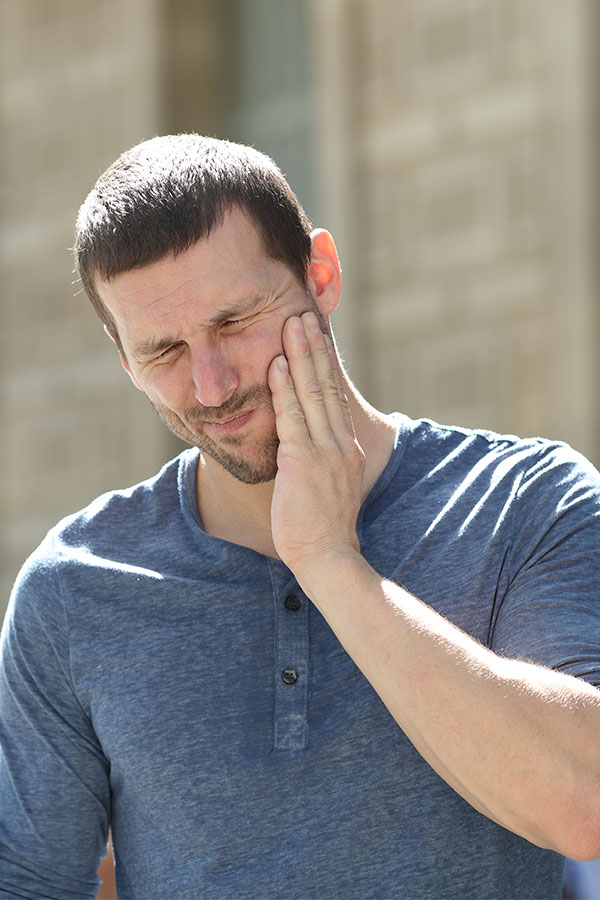Chiropractic Care for TMJ
At our Columbia Falls, Kalispell, and Whitefish chiropractic offices, we see several patients who suffer from TMJ. If you’re wondering… Does seeing a chiropractor help with TMJ? The answer is yes!

Do you ever experience the following pains?
- Jaw pain and tenderness
- Popping and clicking in the joints of your jaw
- Locking of the jaw in an open or closed position
Those are just a few of the many symptoms associated with the condition known as “TMJ.”
What is TMJ?
TMJ stands for temporomandibular joint, a.k.a. the joints of your jaw. When referring to problems or dysfunction of these joints, we use the acronym “TMD” (temporomandibular dysfunction), which will be used for the remainder of this page.
About TMD
Here’s a quick breakdown on TMD, and it’s worth the read whether you think you have this condition or not because:
If you think that you’re suffering from this condition, you’ll better understand the issue and have a good idea of what you’re getting yourself into if you choose to seek treatment.
If you don’t have this condition – you will learn about the causes behind the development of this condition, which will help you stay TMD-free.
What is TMD?
TMD is a complex disorder often dealing with a combination of muscle imbalance, articular/joint dysfunction, and postural problems resulting in pain, jaw dysfunction, and eventually degeneration.
Muscle imbalance
Throughout the body, joints are surrounded by muscles. The tension of the surrounding muscles controls the position of the joint.
Ideally, the muscles act on the joint in an equal/balanced way resulting in good joint control and no pain.
But when the pull from the surrounding muscles isn’t so well balanced, this can lead to pain and dysfunction due to the uneven pressure on the joint. Muscle imbalance typically plays a significant role in the development of TMD.
Joint dysfunction
Damage to the temporomandibular joint itself is often the product of muscle imbalance, but in some cases, joint problems can be the primary source of TMD.
Trauma to the joint via a blow to the jaw often results in TMD. Other issues such as osteoarthritis, inflammatory forms of arthritis, and infections can affect the joint and result in TMD.
Joint restrictions in the cervical and thoracic spinal segments are also strongly associated with TMD. Joint manipulation of these regions has proven to be one of the most powerful forms of treatment for this condition.
Postural problems
There is a very high correlation between forwarding head posture and forward rolled shoulders and TMD development.
As the head is held out in front of the chest, this creates muscle imbalance as the muscles in the back of the neck are forced to work harder to keep the head upright.
Forward head posture also puts the muscles in the front of the neck slack, making it difficult for the muscles we use to open our mouths to perform their job.
Eventually, this will lead to joint restrictions, so you can see that this is a vicious cycle.
Who gets TMD & Key Indicators?
- Over 3% of Americans seek treatment for TMD yearly, and it is suspected that there is a much higher percentage of the population struggling with this condition but going untreated.
- The average age range of TMD patients is 20-50, and females are 2-3x more likely to develop TMD than males.
- Psychosocial problems such as stress, anxiety, and depression are widely accepted as factors leading to a higher likelihood of developing TMD.
- Habits such as nail-biting, finger/thumb sucking, cheek/tongue biting, and mouth breathing are also strongly associated with the onset of TMD.
- Teeth clenching and bruxing (rhythmic clinching) are significantly associated with TMD, and these habits are often subconscious, meaning the patient is likely unaware that they are doing it.
How do I know if I have TMD?
- If you experience popping, clicking, or locking of the jaw in an open or closed position.
- Jaw pain while chewing and ear pain are symptoms indicative of TMD
Clinical pearl: teeth clenching and grinding at night often produce headaches. If you wake up with headaches and jaw pain, you are highly likely clenching while sleeping.
How do I know if I have TMD?
- If you experience popping, clicking, or locking of the jaw in an open or closed position.
- Jaw pain while chewing and ear pain are symptoms indicative of TMD
- Clinical pearl: teeth clenching and grinding at night often produce headaches. If you wake up with headaches and jaw pain, you are highly likely clenching while sleeping.
How is TMD treated at Whitefish Chiropractic Center?
Soft tissue techniques:
As mentioned previously, muscle imbalance often plays a significant role in the onset of TMD.
We need to reduce tension in excessively tight muscles acting on the jaw to normalize the jaw's function.
To do this, we utilize a variety of soft tissue tools such as Active Release Technique, Dry Needling, and PIR (post-isometric relaxation) to return the surrounding muscles to their normal resting tone.
Joint manipulation:
Although we rarely adjust the jaw's joints, manipulating restricted joints in the cervical & thoracic spine has proven to be one of the most effective methods in the treatment of TMD.
Functional rehabilitation:
Once the joints are moving freely and the normal tone of the surrounding muscles has been restored, we utilize rehab exercises to re-train the muscles acting on the jaw to work together in a balanced way.
Education:
Teaching the patient-important things like the rest position of the jaw as well as certain foods and habits to avoid helps us get you out of pain fast + achieve lasting results.
Let the docs at Whitefish Chiropractic help you out!
TMD can start as an annoying pop or click, but if left untreated, it can result in excruciating pain, headaches, loss of sleep, and eventually degeneration of the temporomandibular joints.
